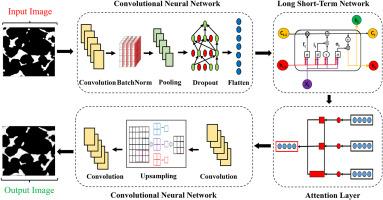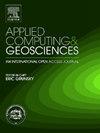Reconstruction of reservoir rock using attention-based convolutional recurrent neural network
IF 3.2
Q2 COMPUTER SCIENCE, INTERDISCIPLINARY APPLICATIONS
引用次数: 0
Abstract
The digital reconstruction of reservoir rock or porous media is important as it enables us to visualize and explore their real internal structures. The reservoir rocks (such as sandstone and carbonate) contain both spatial and temporal characteristics, which pose a big challenge in their characterization through routine core analysis or x-ray microcomputer tomography. While x-ray micro-computed tomography gives us three-dimensional images of the porous media, it is often impossible to quantify the variability of the pore, grains, structure, and orientation experimentally. Recently, machine learning has successfully demonstrated the reconstruction ability of reservoir rock images or any porous media. These reservoir rock images are crucial for the digital characterization of the reservoir. We propose a novel algorithm consisting of the convolutional neural network, an attention mechanism, and a recurrent neural network for the reconstruction of reservoir rock or porous media images. The attention-based convolutional recurrent neural network (ACRNN) can reconstruct a representative sample of reservoir rocks. The reconstructed image quality was checked by comparing them with the original Parker sandstone, Leopard sandstone, carbonate shale, Berea sandstone, and sandy medium images. We evaluated the reconstruction by measuring pore and throat properties, two-point probability function, and structural similarity index. Results show that ACRNN can reconstruct reservoir rock or porous media of different scales with approximately the same geometrical, statistical, and topological parameters of the reservoir rock images. This deep learning method is computationally efficient, fast, and reliable for synthetic image realizations. The model was trained and validated on real images, and the reconstructed images showed excellent concordance with the real images having almost the same pore and grain structures. The deep learning-based digital rock reconstruction of reservoir rock or porous media images can aid in rapid image generation to better understand reservoir rock or subsurface formation.

利用基于注意力的卷积递归神经网络重建储层岩石
储层岩石或多孔介质的数字重建非常重要,因为它能使我们直观地了解和探索其真实的内部结构。储层岩石(如砂岩和碳酸盐岩)包含空间和时间特征,这给通过常规岩心分析或 X 射线微计算机断层扫描来描述其特征带来了巨大挑战。虽然 X 射线微计算机断层扫描可以提供多孔介质的三维图像,但通常无法通过实验量化孔隙、晶粒、结构和取向的变化。最近,机器学习已经成功证明了储层岩石图像或任何多孔介质的重建能力。这些储层岩石图像对于储层的数字化特征描述至关重要。我们提出了一种由卷积神经网络、注意力机制和递归神经网络组成的新算法,用于重建储层岩石或多孔介质图像。基于注意力的卷积递归神经网络(ACRNN)可以重建具有代表性的储层岩石样本。通过与原始的帕克砂岩、豹纹砂岩、碳酸盐页岩、贝里亚砂岩和砂质介质图像进行比较,检查了重建图像的质量。我们通过测量孔隙和喉管属性、两点概率函数和结构相似性指数来评估重建结果。结果表明,ACRNN 可以重建不同尺度的储层岩石或多孔介质,其几何、统计和拓扑参数与储层岩石图像大致相同。这种深度学习方法的计算效率高、速度快,而且对合成图像的实现非常可靠。该模型在真实图像上进行了训练和验证,重建后的图像与具有几乎相同孔隙和晶粒结构的真实图像非常吻合。基于深度学习的储层岩石或多孔介质图像的数字岩石重建有助于快速生成图像,从而更好地了解储层岩石或地下地层。
本文章由计算机程序翻译,如有差异,请以英文原文为准。
求助全文
约1分钟内获得全文
求助全文
来源期刊

Applied Computing and Geosciences
Computer Science-General Computer Science
CiteScore
5.50
自引率
0.00%
发文量
23
审稿时长
5 weeks
 求助内容:
求助内容: 应助结果提醒方式:
应助结果提醒方式:


